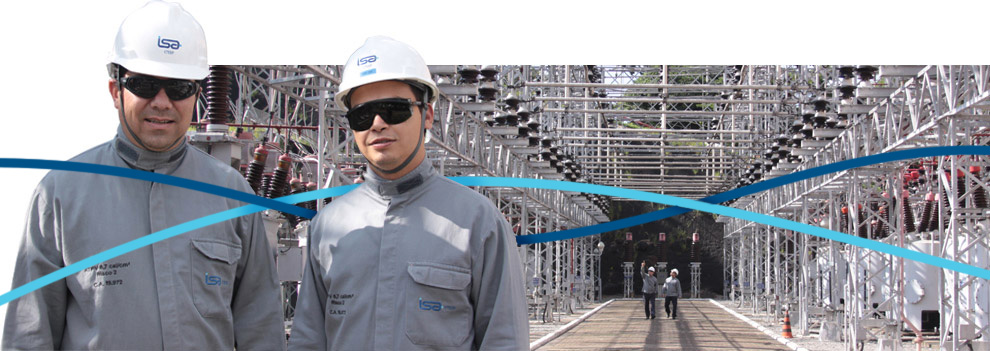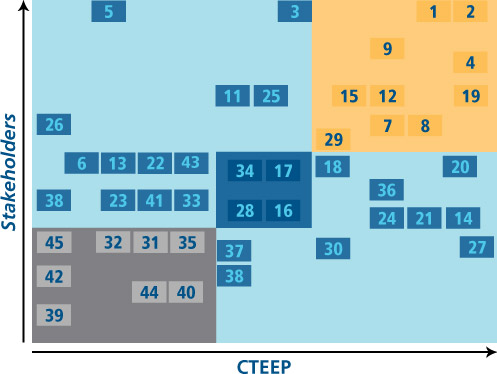This is CTEEP Annual and Sustainability Report that, for the third consecutive year, reports its results in line with GRI (Global Reporting Initiative) international guidelines. One of the highlights in 2010 was the evolution on the level of application that came from C to B. This report also follows the recommendation of ANEEL (Agência Nacional de Energia Elétrica) model to prepare the annual and social-environmental responsibility report of electric energy companies. [GRI 3.2, 3.3]
The report covers operating, economic-financial, social-environmental results of the operations maintained in Brazil by CTEEP, as well as its subsidiaries, related to the period from January 1, 2010 to December 31, 2010. The financial information is presented based on consolidated amounts in BRL Reais, in compliance with the corporate Law in force and effect, and was submitted to Ernst & Young Auditores Independentes S.S. external auditors. The operating, social and environmental information was internally ascertained and has not been submitted to external verification. All the comparisons made refer to the same period of 2009, except where stated otherwise. [GRI 3.1, 3.6, 3.7, 3.8, 3.9, 3.10, 3.11, 3.13]
In addition to counting on the engagement of employees of several areas and levels of the Company, the process of developing and defining this report content is coordinated by the areas of Communication and Strategic Management and by the Finance and Investor Relation Executive Board. The final Information validation involves the Chief Executive Officer, officers and managers. [GRI 3.5]

Materiality Matrix [GRI 3.5]
This year, CTEEP took an important step towards strengthening the relationship with its stakeholders: the process of setting the contents of this annual and sustainability report was developed based on a tool called materiality matrix.
The application of a materiality matrix consists of identifying the opinions on the topics regarded as priority for the several groups of interest, on one side, and for the Company on the other side.
The survey for such information was conducted through a questionnaire, which was prepared following the GRI guidelines to assure that the engagement would be fully aligned with the process of preparing CTEEP sustainability reports – that is guided by such precepts since 2008.
The questionnaire questions on materiality were divided into three main aspects: social, economic and environmental aspects, reaffirming the importance of the sustainability tripod. The questionnaire was accessed from an electronic address sent by e-mail to the four defined groups of stakeholders – customers, suppliers, employees and stockholders – and was available for answering for 45 days. [GRI 4.14]
This process is expected to develop in the following years, enabling deeper engagement with the publics already selected and inclusion of new groups of interest. [GRI 4.16]
Committed to the materiality matrix results, from 2011 on, CTEEP will start reporting the PR1 and PR2 indicators, directly related to the topics regarded as relevant. Both indicators were not addressed in previous reports, but their monitoring has already been started, in order for the Company, over the following years, to improve their results and show the stakeholders the efforts promoted in the search for an ever more comprehensive content report. [GRI PR1, PR2]
The data presented below show the final result of this engagement process, of which information is addressed and presented throughout the report. [GRI 4.17]

| Position in Matrix | Topic | Related GRI Indicator |
| 1 | To be a financially solid and attractive company for investments. | EC1/EC3/EC4/EC5 |
| 2 | Not to admit any kind of discrimination inside the Company and in all relationships with its stakeholders. | HR4 |
| 4 | To have initiatives in its operations to reduce the environmental impacts. | EN26 |
| 7 | To offer our customers quality services of maintenance and preservation of their lines. | PR1/PR2/PR8/PR9 |
| 8 | To offer benefits to the employees (such as medical assistance, private retirement plan, Christmas Hampers, meal ticket or ticket restaurant). | LA3 |
| 9 | To make investments in public benefit infrastructure, measuring and following up their results. | EC8 |
| 12 | To demand no use of child labor by its business partners. | HR6 |
| 15 | To promote initiatives having as purposes to offer low energy consumption services and efficient use of the water in their operations. Ex: water reduction and reuse. | EN8/EN9/EN10 |
| 19 | To promote and develop studies which encourage to use renewable fuel in substitution for that of fossil origin in their substations and logistics process, thus supporting low carbon economy. | EN3 |
| 29 | Encourage the suppliers to adopt the good sustainability practices. | EC6/HR2/PR1 |
| Position in Matrix | Topic | Related GRI Indicator |
| 16 | To enhance and expand community programs. | SO1/EC8/EC9 |
| 17 | To encourage policies or practices of product purchases from Brazilian suppliers and/or places, having in view the development of the places where CTEEP is present. | EC6 |
| 28 | To demand no use of forced or compulsory labor by its business partners. | HR7 |
| 34 | To be a company with future projection. | Indicadores EC |
| Position in Matrix | Topic | Related GRI Indicator |
| 3 | To guarantee a safe work environment, not harmful to employees’ health. | LA6/LA9 |
| 5 | To fight corruption in all relationships in which CTEEP is involved. | SO2/SO4 |
| 6 | To have policies or practices for environment awareness. | Indicadores EN |
| 11 | To offer the employees internal skills development and training. | LA10/LA12 |
| 13 | To perform career and management analysis programs based on skills per employees´ performance. | LA11 |
| 14 | To demand health and safety related procedures from its suppliers and third parties, in all stages of their services. | PR1/PR2 |
| 18 | To encourage and invest in the employees´ skill training, offering scholarships and/or supplementary courses (for example: foreign language courses and graduation studies). | Indicadores LA |
| 20 | To follow up and monitor the impact of the operations on the neighboring communities. | SO1 e EC8 |
| 21 | To mobilize the employees for adoption of the Code of Ethics. | 4.8 |
| 22 | To have a policy or practice of disposal and destination of materials, for its employees and suppliers. | EN16/EN25 |
| 23 | To improve communication mechanisms, rendering of accounts, equity and corporate responsibility present in CTEEP´s governance standards. | LA4/LA5 |
| 24 | To invest in its processes, pursuing activities and innovative solutions. | Indicadores PR |
| 25 | To extend the certifications and specifications to all CTEEP transmission lines and substations, such as OHSAS 18001 and ISO 14000. | Indicadores PR |
| 26 | To invest in reputed environmental initiatives. | Indicadores EN |
| 27 | To invest in programs and forms of relationship with the community. | Indicadores SO |
| 30 | To promote the same opportunities and salaries for men and women. | LA14 |
| 33 | To be a leading company in its sector and with international projection. | Indicadores EC |
| 36 | To have a policy for using certified materials and monitoring materials employed in the operation. | EN1 |
| 37 | To develop supplementary studies, in addition to the legislation in force, on the impacts of the transmission lines on forest regions. | EN12 |
| 38 | To develop studies related to impacts on agriculture production in the servitude area of the Company´s transmission lines. | EN11/EN15 |
| 41 | To offer an open channel for contact, efficient to listen to the opinion of its publics. | PR5 |
| 43 | To facilitate and encourage the communication among the employees and officers of the Company. | LA4/LA5 |
| Position in Matrix | Topic | Related GRI Indicator |
| 31 | To invest in reputed social initiatives | Indicadores SO |
| 32 | To encourage and provide programs for skill management, per employees´ employability and/or maintenance of employees´ income at the end of the career. | LA11 |
| 35 | To support studies on noise reduction and the likely impacts of the electromagnetic fields of the transmission lines. | Indicadores EN |
| 39 | To encourage the participation of employees in the highest governance body committees, reaffirming dialogue and engagement, thus, promoting transparency in internal relationships. | LA13 |
| 40 | To cooperate with local governments, working together to develop the society. | SO5/SO6 |
| 42 | To work for the continued improvement in its methods of disseminating economic information to strengthen its communication with the stakeholders. | EC1 |
| 44 | To guarantee and encourage freedom of an employee to join a labor union. | HR5 |
| 45 | To assure that agreements with business partners have clauses related to human rights. | HR1 |





